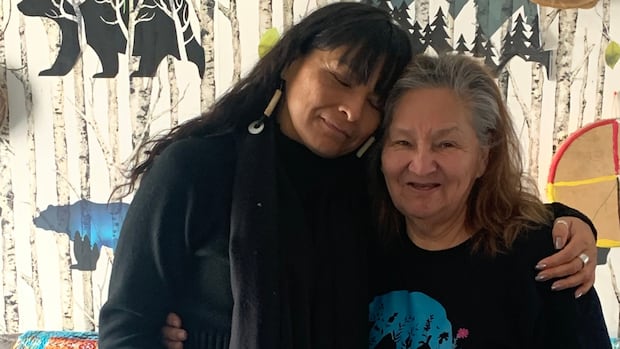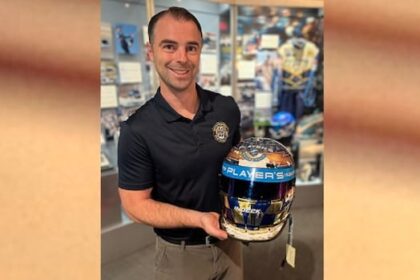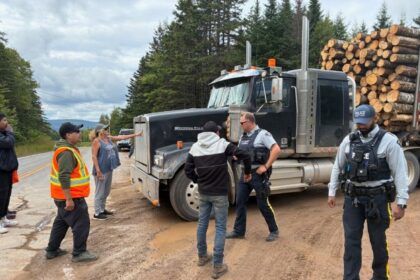It’s been four decades but Leticia Racine is still trying to make sense of a battle over her custody that went all the way to the Supreme Court of Canada — and the impact the landmark case has had on her and other Indigenous kids in the years since.The case cut her off from her biological family, her culture and even her own identity for decades.”I wasn’t ever told that I was Ojibway and Dakota. Like, that was never a conversation growing up,” Leticia said in an interview for the CBC News podcast See You in Court. The podcast takes a deep dive into Leticia’s story in a three-part series, along with seven other legal cases that have shaped life in Canada. Leticia’s journey into care began just a few weeks after she was born in 1976. She was the third child of Linda Daniels, who was then known by her married name Linda Woods.”When they brought her to me, oh my God. Just a beautiful baby. You know, new Anishinaabe girl,” said Daniels, a member of Long Plain First Nation in Manitoba.She gave the baby to child and family services as she struggled with alcohol as a result of her experience at Sandy Bay residential school. Daniels said she was also dealing with domestic violence from her husband who was not Leticia’s father.”He had threatened my life, so they had to put me in care to keep me safe,” Leticia said.A chance encounter brought Leticia into contact with her eventual foster parents, Sandra and Allan Racine, who lived near Deloraine, Man.Allan died in 2019 and Sandra declined an interview for See You in Court, but Leticia says Sandra told her she loved her instantly.The two bonded quickly, according to Leticia, who was seriously ill at one point. “I had pneumonia and bronchitis at the same time, and she healed me,” she said. Legal battlesDaniels and the Racines would spend three years privately battling over the girl.Daniels went to the Racines home more than once to get Leticia back, but they refused. When she got sober, she said she continued her efforts by going to child and family services, legal aid, and even the RCMP. None of it worked out.Things changed when one of Canada’s first Indigenous child welfare agency, Dakota Ojibwe Child and Family Services (DOCFS), got involved.The day in 1978 Sandra Racine handed over Leticia to Linda Daniels after nearly a year of fostering her. ‘It was so heartbreaking for [Sandra],’ Leticia says. (Radio-Canada)The agency was founded toward the end of the Sixties Scoop, a period when an estimated 20,000 Indigenous children were given to non-Indigenous families. Daniels repeatedly said she was concerned about her daughter not knowing her culture, and wanted to raise her daughter herself. “I wanted her to be treaty, to know who her ancestors were,” she said. Case settled by Supreme CourtThe case went to provincial court in 1982 and the adoption was allowed. The judge ruled that Daniels abandoned Leticia, and that Allan Racine, who was Métis, would be able to support her as she dealt with racism and discrimination, as she faced racism in their largely white community.Daniels appealed and the appeal court judges overturned the adoption, but gave no order to return Leticia to Daniels — instead suggesting visits and contact with Linda might be arranged.Both sides appealed to the Supreme Court of Canada in 1983, when Leticia was seven.”I remember praying, like, I couldn’t comprehend being taken away from my mom and dad,” said Leticia. A newspaper clipping from the Winnipeg Free Press in 1982 shows a photo of a meeting between Linda and Leticia when she was five. (Winnipeg Free Press)Ultimately, the Supreme Court weighed the importance of the bond she had with the Racines against the importance of her connection to her birth mother — and their culture — to determine what was in the child’s best interests.The ruling said that ethnic heritage and cultural background can diminish in importance over time and “the closer the bond that develops with the prospective adoptive parents the less important the racial element becomes.” The Supreme Court allowed the Racines to adopt Leticia and maintain full custody of her. As a last ditch effort, Daniels asked a judge to give her visitation rights. Instead, she was barred from contacting her daughter for five years. ‘Not yesterday’s story’The case set a precedent that “enshrined the bonding to foster parents as some sort of a holy, you know, thing that couldn’t be disrupted,” said Raven Sinclair, dean of social work at University nuhelot’ine thaiyots’i nistameyimâkanak Blue Quills in St. Paul, Alta.It also undermines what Sinclair, a Sixties Scoop survivor, says she tells courts: that most Indigenous kids who are removed from their cultures eventually look for it. Racine v. Woods was just one part of a series of policies and court cases that allowed Indigenous kids to be removed from their families and cultures, according to child welfare advocate Cindy Blackstock.She points to three phases in the process: residential schools, the Sixties Scoop and the creation of provincial child welfare organizations. That led to “a whole cascade where mass removals of these kids would happen,” Blackstock said. In fact, more Indigenous kids are in care today than were in residential schools at their peak. “This story of the state removals of Indigenous children is not yesterday’s story,” Blackstock added.Leticia did experience issues around her identity as a teen, the way some experts had predicted. “I started to recognize that I was different. That I was Native,” she said.”I would come home and try to wash my skin off and try to figure out how I could not be brown anymore.”Leticia said she remembers Sandra telling her that if she didn’t “smarten up,” Sandra would put her back into care. Sandra would eventually follow through on putting her back into foster care when Leticia was 13. “I couldn’t stop crying after that because I was losing my family, like I was being kicked out of my family,” Leticia said.LISTEN | The court case that changed Leticia Racine’s life: The Current24:46A custody battle that became a landmark case: Racine v WoodsAfter that she was incarcerated several times as a teenager — including for armed robbery — but by the 1990s she ended up in a program run by Katherine Morrisseau-Sinclair and Murray Sinclair, who later became chair of the Truth and Reconciliation Commission. Then, she attended her first sweat lodge with the Sinclairs. “The prayers that were offered up in that ceremony probably saved my life,” Leticia said. Leticia Racine said she has healed enough to be able to raise her youngest child, Thunder, in their culture. (Submitted by Leticia Racine)These days, as an advocate for Sixties Scoop survivors, Leticia says her views on the court ruling have changed over time. Initially, she said, she thought the courts got it right. “I did get a good education… but I didn’t have ceremony, I didn’t have culture, I didn’t have identity,” she said. “Despite those gifts that I did get, in the end I would have rather been with my people.”
Saturday, 15 Nov 2025
Canada – The Illusion
Search
Have an existing account?
Sign In
© 2022 Foxiz News Network. Ruby Design Company. All Rights Reserved.
You May also Like
- More News:
- history
- Standing Bear Network
- John Gonzalez
- ᐊᔭᐦᑊ ayahp — It happened
- Creation
- Beneath the Water
- Olympic gold medal
- Jim Thorpe
- type O blood
- the bringer of life
- Raven
- Wás’agi
- NoiseCat
- 'Sugarcane'
- The rivers still sing
- ᑲᓂᐸᐏᐟ ᒪᐢᑿ
- ᐅᑳᐤ okâw — We remember
- ᐊᓂᓈᐯᐃᐧᐣ aninâpêwin — Truth
- This is what it means to be human.
- Nokoma












